
New pay models, insurer pressures raise anxiety
Urologists listed increasing government regulations, declining reimbursement, increasing overhead, and the Affordable Care Act as their most pressing concerns in Urology Times’ 2014 State of the Specialty survey.
National Report-It’s the same story, but with a few new twists.
Urologists listed increasing government regulations, declining reimbursement, increasing overhead, and the Affordable Care Act as their most pressing concerns in Urology Times’ 2014 State of the Specialty survey. All four of those pain points also topped the list in last year’s survey.
New, but related challenges emerged this year: new payment models, increasing pressure by payers to follow guidelines, quality metrics/reporting requirements, and narrow insurance networks. All were newly added choices to a closed-ended question about the issues urologists are concerned about, and all ranked in the top 10 among 16 possible responses.
The survey suggests that these administrative burdens, rules, and regulations are not only concerning, but also weigh heavily in urologists’ decision on retirement. The federal government’s increasing influence in medicine, declining reimbursement, and burnout were the top three factors influencing their decision about when to retire. With one-fourth of respondents planning to retire in the next 5 years, access to urologic care could become problematic (see also, “Docs’ frustration may hinder access to care").
In another finding that could impact the urology work force, only one-third of urologists who are currently age 45 or younger and have a time-limited certificate from the American Board of Urology (ABU) plan to recertify when they reach age 60.
The State of the Specialty survey is now in its ninth year. Its goal is to identify the challenges, business-related practices, clinical trends, and demographic changes that are shaping the face of urology. Responses this year were cross tabulated by urologists’ practice setting, practice size, and age. Such breakdowns show notable differences in electronic health record (EHR) usage, career satisfaction, and whether a urology practice’s ownership of an intensity-modulated radiation therapy (IMRT) facility is a conflict of interest.
The survey was developed independently by Urology Times and carried out by Readex Research, a national research company. Responses were collected via an online survey sent to active Urology Times subscribers in fall 2014. The margin of error based on 225 respondents-all urologists or urology residents-is 6±4 percentage points at the 95% confidence interval. (Also see,
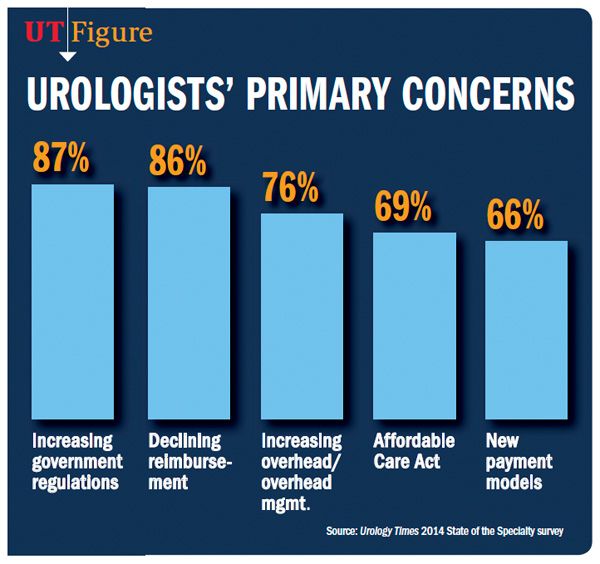
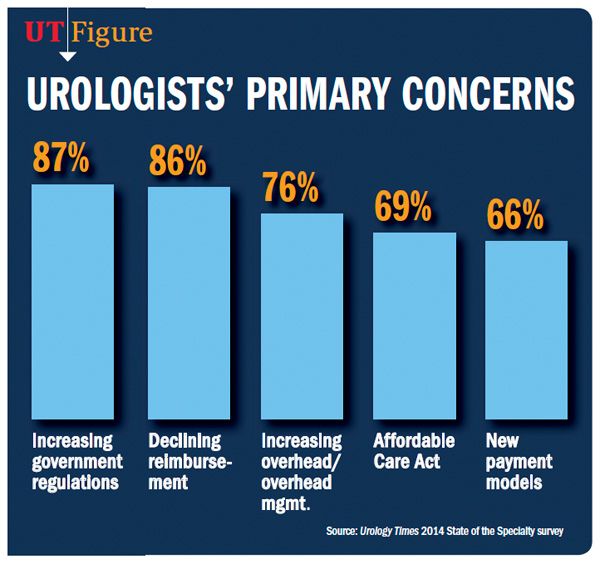
Top concerns, challenges
Urologists’ concerns relate almost universally to rapidly evolving U.S. health policy and the challenges it entails. Nearly the same number of urologists said they are most concerned about increasing government regulations and declining reimbursement (87% and 86%, respectively), the survey showed. Rounding out the top five concerns from a provided list were increasing overhead (76%), the Affordable Care Act (69%), and new payment models, such as bundled payments (66%).
New to the list of top 10 concerns (and to the survey questionnaire) in 2014 were pressure by insurers to follow guidelines (65%), quality metrics and reporting requirements (64%), the transition to the International Classification of Diseases-10 (ICD-10) coding system (54%), and smaller/narrow insurance networks (50%). In contrast to the 2013 survey, concern about possible restrictions on urologists’ ability to refer patients to certain practice-owned ancillary services lessened somewhat (47% vs. 53%).
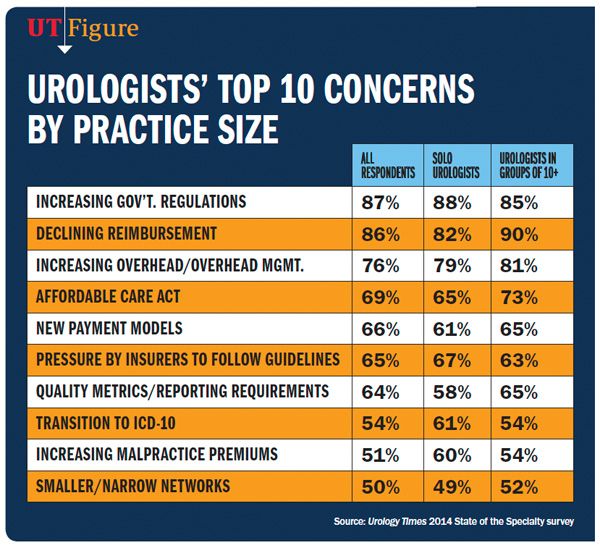
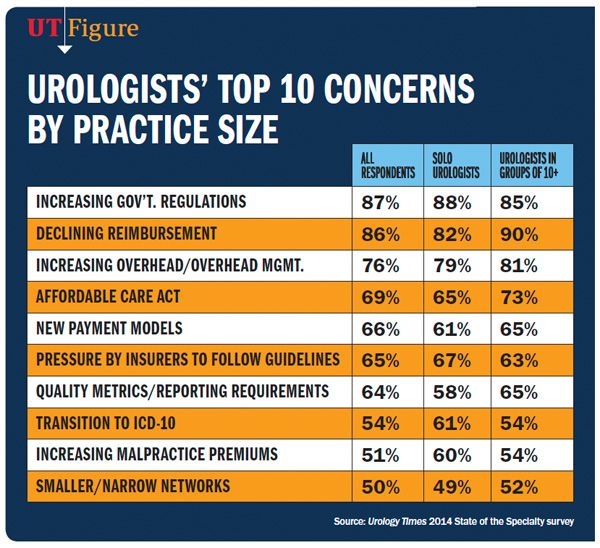
“I think these higher rankings point out that financial issues occupy the minds of practicing urologists much more these days than other concerns,” Rick Rutherford, CMPE, CHA, the AUA’s director of practice management, told Urology Times. “Further control of the health care costs in the U.S. is inevitable, and practicing physicians will survive. However, the uncertainty brought on by the variety of new ideas about cost controls is very unnerving.
“It is hard to envision competing successfully in a game when you have no idea of the rules under which you must play.”
One fact of life urologists are all too familiar with is the sustainable growth rate (SGR) payment formula, which would see a 21.2% reduction beginning March 31, 2015 unless Congress steps in again to block the cut. James Ulchaker, MD, chairman of the AUA’s Legislative Affairs Committee, still believes permanent reform of the SGR is possible before March 31 (see,
Concern about declining reimbursement is a recurring theme of the State of the Specialty survey. Asked to rate their financial satisfaction with practicing urology on a scale of 1 to 5 (with 5 indicating “very satisfied”), just one-third of respondents overall answered with a 4 or 5. That rating was somewhat higher for urologists belonging to large groups (10 or more physicians) than those in solo practice (41% vs. 32%). In terms of practice setting, the highest level of financial satisfaction was reported by those employed by a hospital (53%), followed by urologists in private practice (33%) and those in academic practice (30%).
Using the same scale to rate their professional satisfaction, respondents gave higher marks: 59% overall and 63% among both those in large groups and solo practice answered with a 4 or 5. Professional satisfaction was highest among private practitioners (62%) and lowest among academics (43%), with hospital-employed urologists in the middle (56%).Asked about the fairness of their compensation compared to that of other surgical specialties, about one-fourth of urologists rate it as a 4 or 5 on a 1-5 scale, with 5 indicating “very fair.” Respondents’ practice size affected the answer to this question. Those in practices of 10 or more were most likely to rate their compensation fairness high (37%), compared to those in solo practice or groups of two to nine (22% and 24%, respectively).
Only half (49%) of respondents said they would make medicine their career choice if they were starting over, 27% said they would not, and 24% were uncertain. Interestingly, only 35% of urologists under age 45 responded positively to this question-the lowest response rate of all age groups. Among those who said they would choose medicine if they had to do it over again, 88% would still choose urology as their specialty.
Retirement/work force trends
Whether career satisfaction relates to retirement plans is open to interpretation, but results of the survey suggest the two may be linked. In a question about their plans for the next 5 years, 26% of urologists said they plan to retire-the number one response in a closed-ended question. Other top responses were: add another urologist to my practice (25%), work locum tenens (11%), become a hospital employed (10%), and seek a job in a non-medical field (8%).

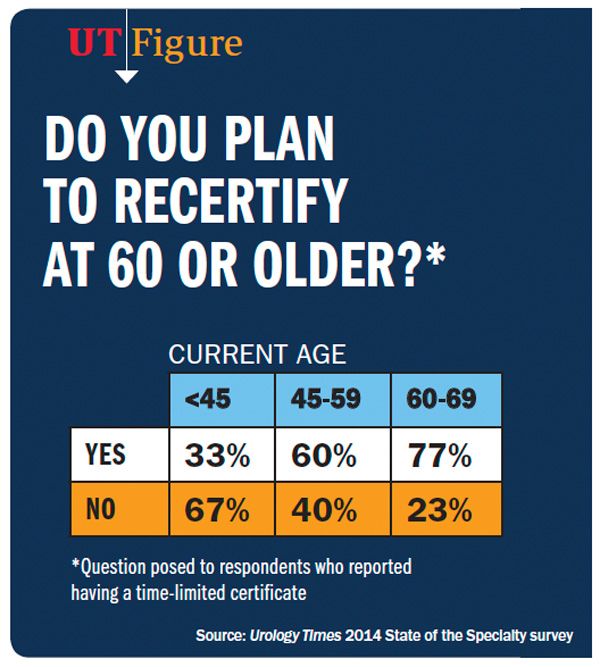
Asked which factors were most influential in the timing of their retirement, the government’s increasing influence in medicine was the top response (65%), followed by declining practice reimbursement (56%), burnout (51%), and managed care’s influence in medicine (44%).
One-third of respondents plan to retire at age 70 or over, and more than half (56%) expect to retire at age 60-69. Forty-one percent said they would retire now if they had enough money.
In a series of questions added to this year’s survey, urologists were asked about ABU certification and recertification. Among the 72% of respondents with a time-limited certificate, 41% said they would not take the recertification exam when they reach age 60 or older. Two-thirds (67%) of urologists under age 45 said they would not recertify at age 40, compared with 40% of those between the ages of 45 and 59.
For nearly three-fourths of respondents (72%), certification or recertification is now required to practice in their hospital.
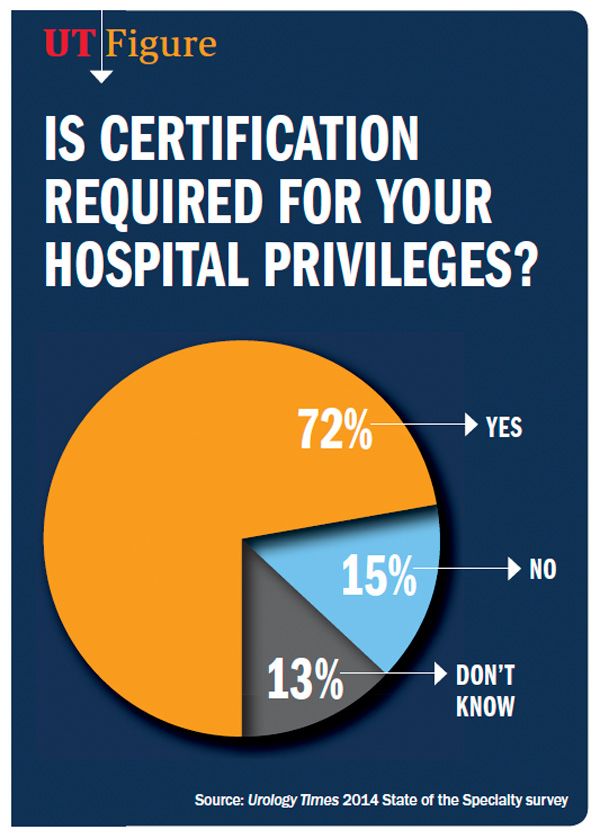

Urologists continue to rely on advanced practice practitioners to meet patient demand while the work force declines. More than one-third (36%) of survey respondents use a physician assistant (PA), and 28% use a certified registered nurse practitioner (CRNP)-numbers similar to those reported in the survey’s 2012 and 2013 installments. Other non-physician providers currently employed by urologists are an RN/LPN (60%), medical assistant (60%), and technologist (26%). By practice setting, academic urologists report the highest usage of both PAs and CRNPs (70% and 48%).
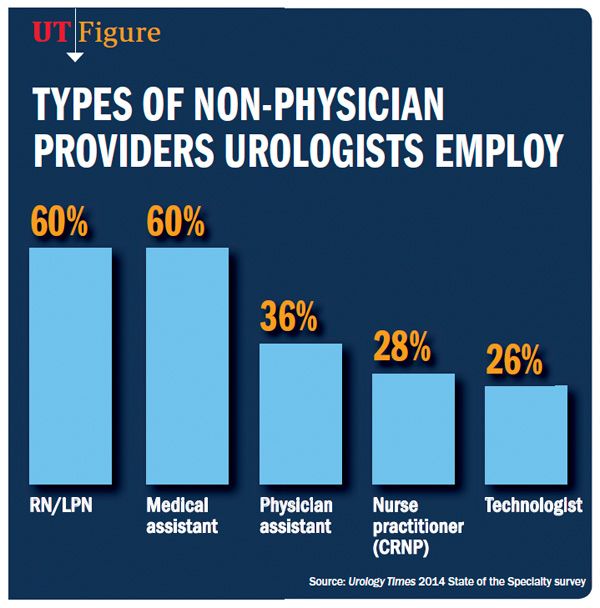
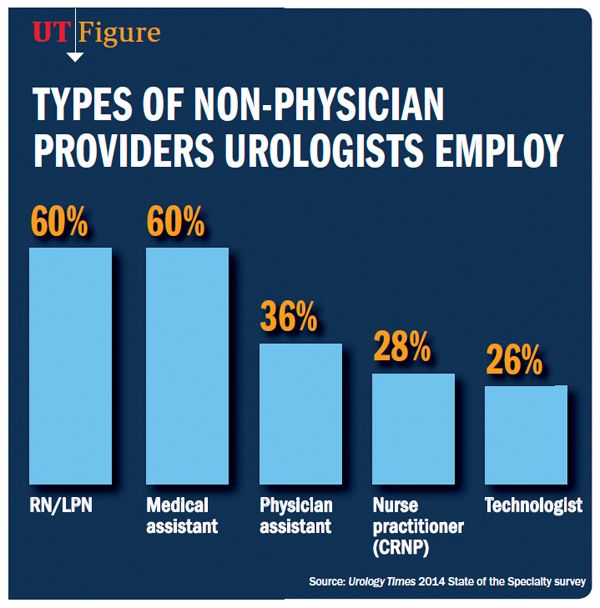
Looking ahead 5 years, 50% of urologists expect their employment of non-physician providers to increase, and 46% expect it to remain the same. Respondents’ practice setting influenced these results somewhat, with urologists employed by hospitals most likely to project an increase in non-physician provider employment (61%), followed by academics (57%), those in “other” settings (50%), and those in private practice (46%). The “other” category includes urologists in a multispecialty group practice, government employees, and those employed by a managed care organization.
“The AUA certainly expects to see an increase in the use of non-physician providers in urology practices in the future. The increasing demand for urology services by the baby boomers coupled with the aging of the existing population of physicians appears to make this growth inevitable,” Rutherford said.
“I am not surprised that anticipated increases appear higher in institutional groups, but the expectations of private-practice urologists indicate almost half of them see increased usage in the next 5 years. Clearly, the larger practices have the financial wherewithal to support the non-physician provider in the 12- to 18-month time frame until they become fully productive professionals in specialty practices.”
The decision by many urologists to become hospital employed, first examined in the survey 2 years ago, appears to be leveling off. Just over one-fifth (29%) said they were considering hospital employment this year, compared to 36% in 2013. (As noted above, only 10% of urologists indicated they would become a hospital employee in a question about their 5-year plans, a discrepancy possibly related to differences in how the two questions were phrased.) Sixteen percent report being employed by a hospital already.

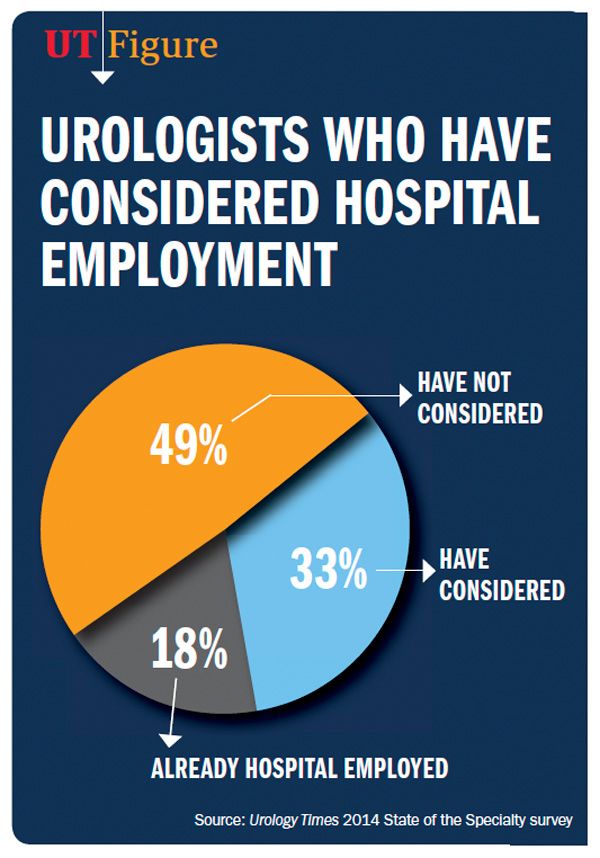
The number one reason for choosing hospital employment is less administrative hassle (68%), followed by better reimbursement (38%), more free time (34%), and job security (23%).
According to Rutherford, “The low percentage of urologists who plan to become hospital employees makes me wonder if we may have reached the apex of this pendulum swing toward employment. Recent data showing higher per-patient costs for services delivered in hospital-based practices and the increasing scrutiny of the payment methodology for outpatient services may signal a swing in the other direction over the next 5 years. Time will tell.”
Business practices
A relatively recent trend among U.S. urology practices is the opening of men’s health centers that offer urologic and non-urologic care. In a new survey question, urologists were asked how likely they were to offer a men’s health clinic. Only 19% of respondents indicated high likelihood of doing so (4 or 5 on a scale of 1 to 5), although that likelihood was higher among those in groups of 10 or more (31%) and those under age 45 (24%). The overall response rate may reflect the age of survey respondents; this year’s survey respondents skewed older, with 44% over age 60.
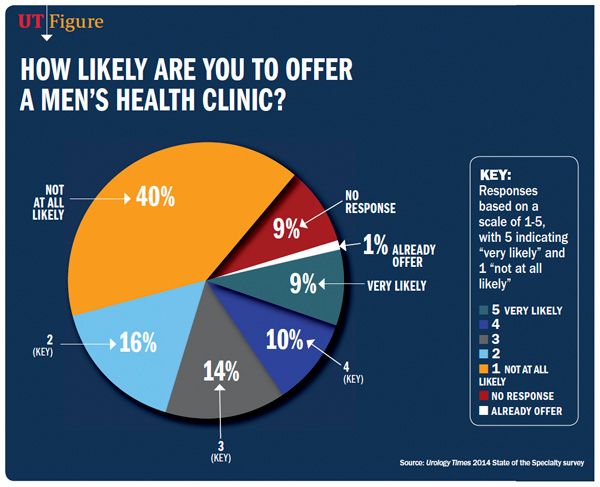
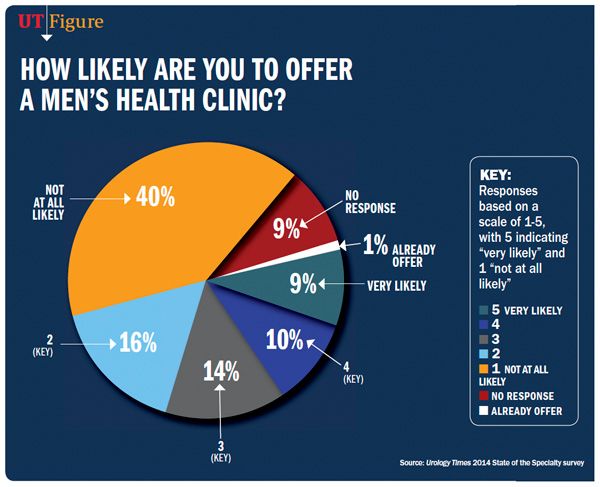
“I suspect the low percentage of those reporting they are likely to institute a men’s health clinic is more directly related to the amount of available time and energy they can allocate to a new venture, especially when the revenue stream from third-party payers is yet unproven,” Rutherford said. “Younger urologists in larger practices are more likely to have the time and more entrepreneurial spirit to cultivate this service line.”
In fact, a single-question online poll conducted by Urology Times in September 2014 showed that 50% of urologists were considering broadening their practice to include a men’s health clinic and that 19% already have one.
A longer-term trend in urology and other specialties has been the shift from electronic systems for patient records and prescribing. Both are at or near their peak, the survey showed, with 83% of urologists indicating use of an EHR and 85% using e-prescribing. A full 100% of academic urologists and 100% of those in large practices now use an EHR, compared with 63% in solo practice and 85% in those belonging to groups of two to nine. Similar results were observed for e-prescribing usage: 98% of urologists in large practices, 86% of those in groups of two to nine, and 74% of solo practitioners.
Clinical practice
Overall, close to three-fourths (70%) of urologists’ procedures are performed endoscopically or percutaneously. Open surgery is the next most common type of procedure (19%), followed by robotic (6%) and laparoscopic surgery (5%). Robotic surgery, not surprisingly, is done more commonly by academic urologists and those in large groups (7% and 10% of all procedures, respectively).
Office-based procedures and hospital outpatient surgery are the procedures urologists spend the most time on, at 7.2 and 6.6 hours per week, respectively. Less time is spent performing hospital inpatient surgery (4.7 hours) and procedures done in an ambulatory surgery center (2.4 hours), although academic urologist spend nearly 10 hours per week in inpatient surgery.
Income and expenses
On average, urologists derive most of their income from patient care (88%), while 12% comes from ownership in an ancillary service or product. Income from patient care represents a higher percentage of the total for academic and hospital-employed urologists (97% each).
Ultrasound and a lithotripsy partnership are the types of ancillary products/services in which urologists most commonly invest (45% each overall and 61% each among those in private practice). Other ancillary equipment or facilities owned/invested in by urologists in general and private-practice urologists are a clinical laboratory (28% and 39%, respectively), in-house pathology (27% and 41%), ambulatory surgery center (24% and 34%), CT scanner (15% and 20%), and IMRT facility (14% and 20%).
Urologists remain divided on whether an IMRT partnership represents a conflict of interest. Half say it does, and half say it does not. Those in academic (70%) and solo practice (58%) more often agreed IMRT ownership is a conflict of interest versus those in private practice (45%) and members of groups of 10 or more (44%).
“The investment costs for this service line make it unrealistic in smaller practices. Those physicians are much more likely to refer to local radiation oncologists and develop more collegial and less competitive relationships with them,” Rutherford said.
Total income-from both patient care and any ancillary services-increased between 2013 and 2012 for only 11% of urologists, while 50% said it decreased and 34% said it stayed the same. Double the number of hospital-employed urologists-22%-reported an increase in income, the highest of any practice setting.
Comparing costs for the same time period, respondents were most likely to report increases in non-physician staff/salary benefits (57%), other, non-salary physician expenses (41%), facility rental (39%), and equipment rental (36%).
Demographics
The survey shows the growth of large practices and the decline of smaller ones. About one-fourth (22%) of respondents belong to groups of 10 or more. Another fourth are in solo practice, but 75% of those urologists are 60 or older.
Among other demographic findings:
- Urologists see an average of 81 patients per week, work an average of 50 hours per week in the practice of urology, and work about 7 hours in practice administration.
- Respondents’ mean age is 56; 92% are male.
- About half (55%) are in private practice, 16% are hospital employed, 10% each are in a multispecialty group or academic practice, and 5% work for the government.
How the survey was conducted
The survey sample of 4,079 consisted of emailable subscribers to Urology Times classified as urologists. Data were collected via online survey in September and October 2014. The survey was closed for tabulation with 232 responses, a 6% response rate. Seven respondents indicating they are not a urologist or urology resident were omitted from the final results. The margin of error based on the remaining 225 respondents is ±6.4 percentage points at the 95% confidence interval. Those who responded were able to enter a drawing for a chance to win one of three $100 Visa gift cards.
Newsletter
Stay current with the latest urology news and practice-changing insights — sign up now for the essential updates every urologist needs.

















